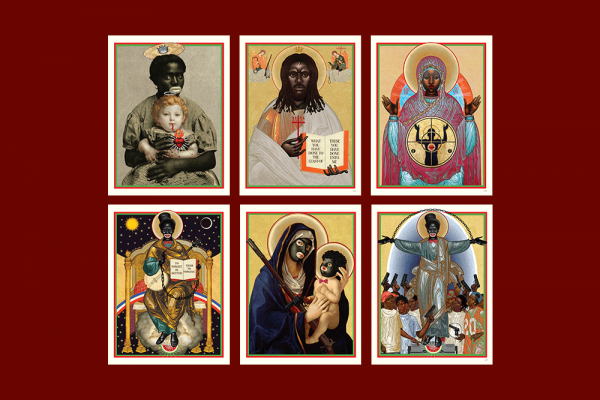As racist ideas continue to plague U.S. politics, Mark Doox’s Afro-surrealist and satirical graphic novel, The N-Word of God, couldn’t have arrived at a better time.
The book is a visual novel told through depictions of anti-Black images — Black people eating watermelons, Jim Crow caricatures, mammies, and blackface — all stylized in the form of Eastern Christian iconography. This is a style that Doox has termed “Byzantine Dadaism.” Doox’s novel deconstructively takes these caricatures that have historically harmed Black people and reimagines them as symbols of Black resilience and healing, restoring the inherent dignity that belongs to every human being, especially those who have been racialized and subjugated by U.S. anti-Blackness.
As an ordained Black iconographer, Doox learned to paint icons as a novice monk at an Eastern Orthodox monastery. In a direct message on Instagram, Doox told me that he is heavily influenced by the “[Patron saints] of the two churches for which I created icons and spent years as an active member: St. Gregory of Nyssa and St. John Coltrane the Divine Sound Baptist.” When he recognized the Eurocentricity of Christian sacred images, he decided to reimagine the purpose of his iconographic work. Not only does Doox want to deconstruct Eurocentric images of God, he also wants to construct alternative images that can help us imagine a fuller picture of humanity.
The novel is provocative, even chilling at times, as Doox’s iconographic artform subverts iconography itself by positioning derogatory and racist caricatures at the center of iconographic reflection. This is in stark contrast to the pristine images of traditional Christian saints and figures.
Instead of a long-haired, European version of Jesus, Doox’s messianic figure is a blackface character named Saint Sambo. Saint Sambo encourages the novel’s Black characters to remain servile, always smile, and avoid complaining by forgetting or denying the realities of anti-Black racism. Doox describes this messianic mission as a journey of “Whiteousness,” or a means of survival by accommodating to white power to simply survive. As Doox explains in an email, “To out wit your opponent you must first be alive.” Doox explained further that, “Saint Sambo teaches Black people a way to survive White power and White ill-will through accommodating White power in their lives and through subterfuge, trickery, and various kinds of wisdom.”
In an email correspondence wtih Sojourners, Doox argues that while it seems that Saint Sambo is preaching the wrong gospel, there is indeed something revolutionary about the minstrelsy practices of many of Doox’s enslaved “ancestors.” Their “faking it” was necessary for their survival.
Doox clarifies that his task as an artist is not “cooning but deconstructing and examining [racial stereotypes] and other Black existential wonders.” In other words, Doox’s provocative style is meant to redeploy racial stereotypes as a means of critiquing the aesthetic of anti-Blackness and recontextualizing these symbols as forms of resistance. By recontextualizing these anti-Black tropes in the form of Christian iconography, Doox critically exposes why these stereotypes are surreal and absurd. But even more provocatively, Doox holds that even though these stereotypes were used to historically oppress Black people, they were also used as a means of survival for many Black people under oppressive and suffocating conditions.
Reading The N-Word of God reminded me of shows and films such as The Boondocks, Atlanta, BlacKkKlansman, and Get Out, which also surrealize stereotypes that have historically subjugated Black people in order to critique stereotypes and imagine Blackness differently. What Doox is doing in The N-Word of God is exposing the racial narratives and stories that undergird anti-Black stereotypes in an attempt to reimagine Black life — and even its own stereotypes — as forms of resistance and survival against anti-Black racism.
Toward the second half of the book, Doox lays out his constructive project. Doox explores how modern ideas of race rely on the Black/white binary. This is a system through which Europeans racialized themselves as “white” and superior over and against enslaved Africans, who were then racialized as “Black.” The Black/white binary has asserted that there are only two kinds of people in the world: white people or Black people. But for Doox, human skin tones cannot be so easily categorized as Black or white since “White and Black people don’t exist.”
Doox wants to imagine an existence outside of the racialized imagination. To this end, Doox casts a vision of humanity in its varied hues. In this regard, Doox provocatively names “White” people as also “people of color” since their “‘White’ is the color of light pink or beige.” Similarly, “Black people” do not have black skin, but are “various shades of brown.”
Doox’s identifying “white” people as “people of color” is one of the most controversial claims in the novel, one that will surely be debated by others engaging with questions of race and identity.
Anticipating pushback, Doox qualifies in the book why he provocatively names white people as “people of color”: to expose the fallacy of “white” identity. People from Europe, who do not literally have white skin, chose to identify as “white” so that they could justify enslaving Black people and exploiting Indigenous lands. Indeed, Doox wholeheartedly agrees that systemic racism is real and concrete, though his novel places a special emphasis on the fictitiousness of racial identity. Doox chooses to emphasize this to get at the heart of why racism exists in the first place. For Doox, then, the fallacy of the Black/white binary as a political paradigm is precisely the underlying structure that produces white racism. It is the logic that drives both whiteness and anti-Blackness.
In his essay “Being ‘White’... and Other Lies,” writer James Baldwin explains how the idea of white identity has brought humanity “to the edge of oblivion.” Because white people think they are white, Baldwin explains, “[T]hey do not dare confront the ravage and the lie of their history. Because they think they are white, they cannot allow themselves to be tormented by the suspicion that all men are brothers.” Baldwin succinctly identifies the paradox: In white people’s attempt to control and define race, they have lost the ability to see themselves and others as human beings.
For Doox, racial identities are simply absurd “illusions” that have created a divided world, wherein stereotypes and derogatory images abound as a result of the racial binary. “White” and “Black” are simply just words that we have let “[make] up our minds,” and in that way, “[make] up a Black and White world in which we now exist.” But Doox urges his readers to take heed, asking, if Europeans were successfully able to make this racial world, “Can not a Black and White world be equally undone?”
Here lies the power of Doox’s argument: The world we live in today is one defined by fear and separation, yet Doox chooses to believe in the possibility of something otherwise.
He chooses to believe in what he calls “hue-manity,” embracing the possibility of celebrating a humanity that is defined by a multiplicity of skin tones and hues, cultures and identities. Doox’s “hue-manity” cannot be categorized through a racial binary. In an email, Doox wrote to me that many people today tend to equate race with skin color and then attempt to “solve” racism by saying, “I don’t see color.” For him, such “colorblindness” is just as problematic because it only perpetuates racism by overlooking and dismissing the particularities of darker-skinned bodies. Doox’s argument for a shared “hue-manity” is thus to argue for a unity that truly and fully embraces difference.
Instead of racial identity, Doox’s “hue-manity” seeks to move our imaginations toward the particularities and specificities of our bodies as a celebration of our differences.
Indeed, race has operated in a way that stratifies our differences, often creating simple binaries to neatly organize our bodies and the world. Ultimately, Doox’s anti-racial imagination seeks to defy binary thinking by embracing and celebrating the pluralities of all our human experiences in deep love and fellowship that transgresses borders.
As Doox concludes his novel, he re-introduces Saint Sambo. After having gone through his messianic journey, Saint Sambo restates the gospel: All along, his message was a call to sustain the aliveness of Black people, and thus, proclaim the possibility of defying anti-Blackness and embracing a liberating love.
Saint Sambo is immediately repudiated and hated by the book’s “White God” when the gospel he preaches comes to full light. He is then cast out of the White God’s sight and is renamed Satan Sambo. Yet, Satan Sambo continues to proclaim his gospel, which takes its name from what the venerated Black musician John Coltrane has called “A Love Supreme.”
“St. John [Coltrane’s] ‘A Love Supreme’ forms the foundational theological orientation guiding my understanding of God and virtue,” Doox told me in an email. “This concept of unity in diversity is rooted in the pursuit of ‘A Love Supreme’ within our relationships and the commonalities we discover there.” This is the gospel of what the olive-skinned, first-century Jesus embodied when he told his disciples, “Just as I have loved you, you also should love one another” (John 13:34).
Doox left me with a haunting sense of tragedy and grief; he exposed the deceptions that continue to corrupt the U.S.’ sociopolitical landscape. Doox calls us to imagine a new life as “hue-manity,” where the borders and categories that we have imposed might be dismantled in fullness, and we might finally embrace each other as we are.
In a poetic rendering toward the conclusion of his book, Doox dreams that his own flesh might be emancipated from the racial imagination, hoping that his readers might do the same:
I am not a color
I am merely human
And my mere humanity
Is enough
Got something to say about what you're reading? We value your feedback!






